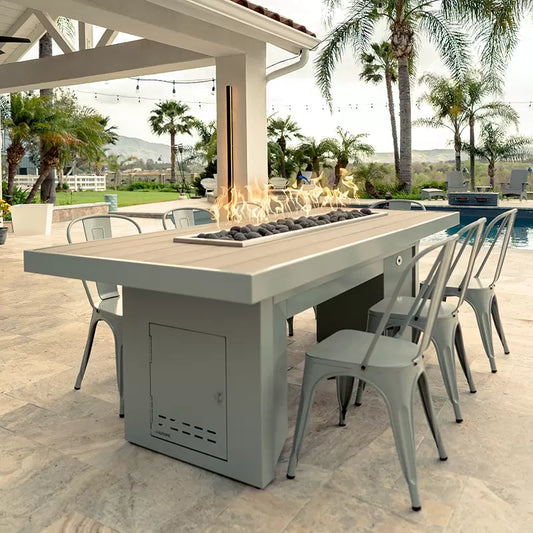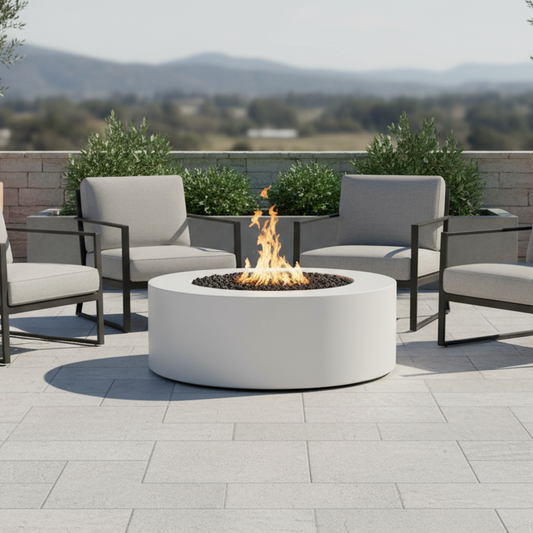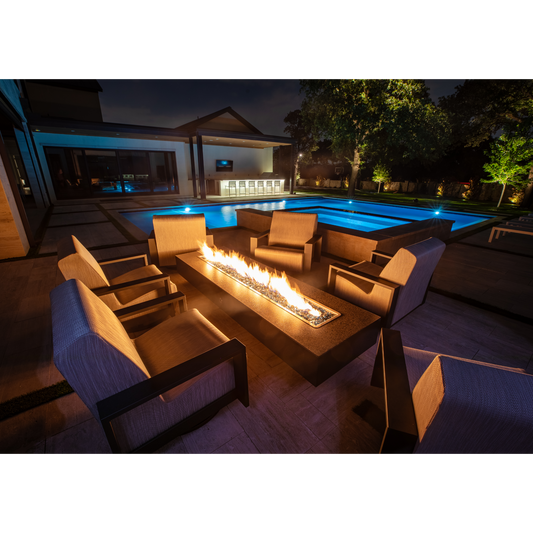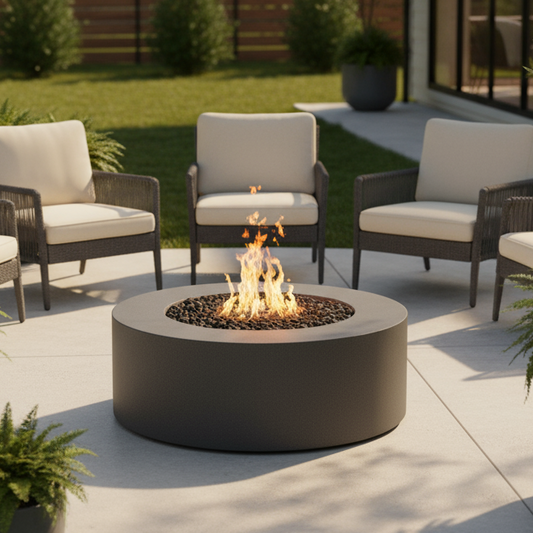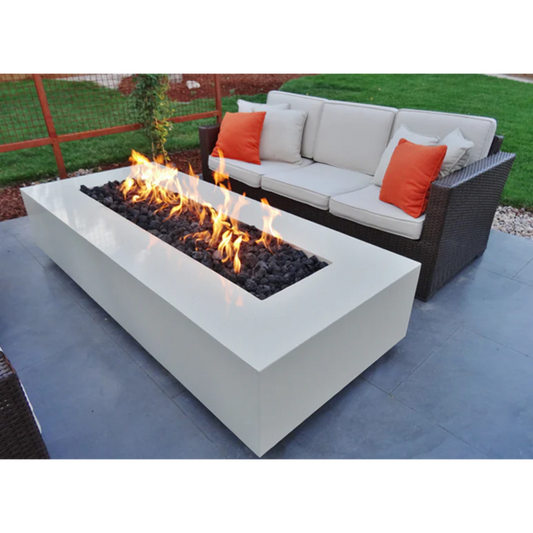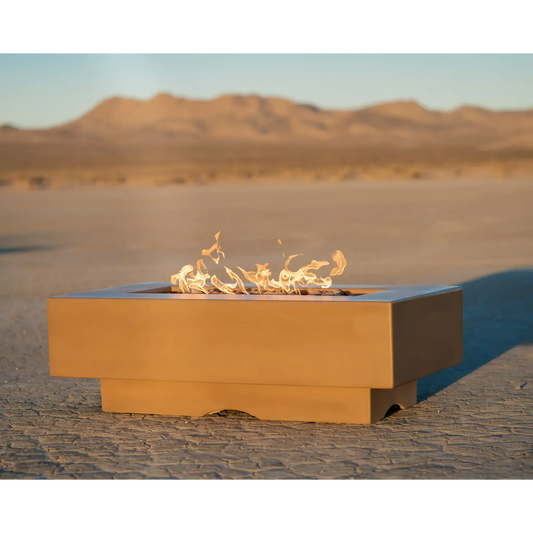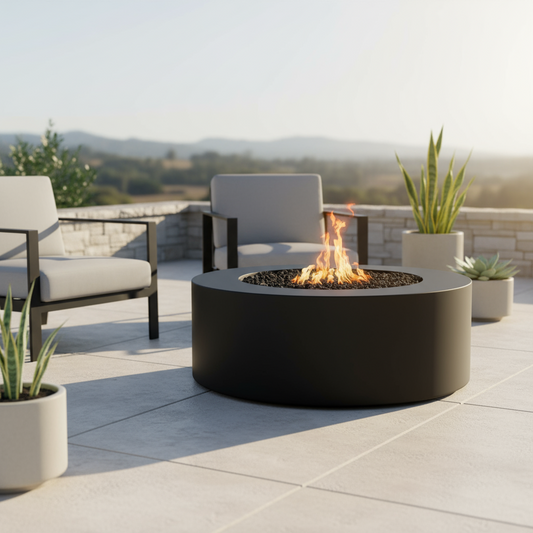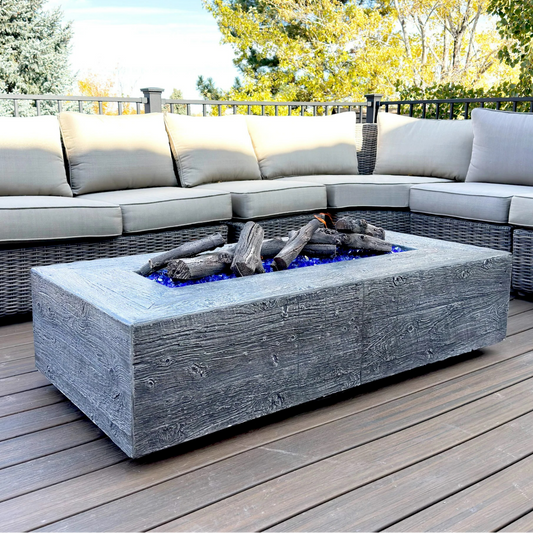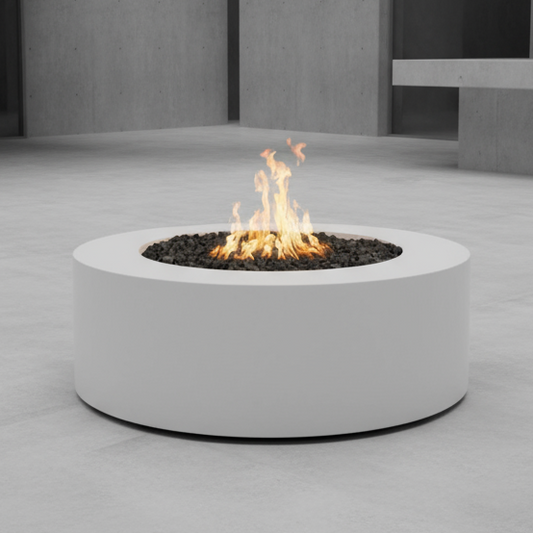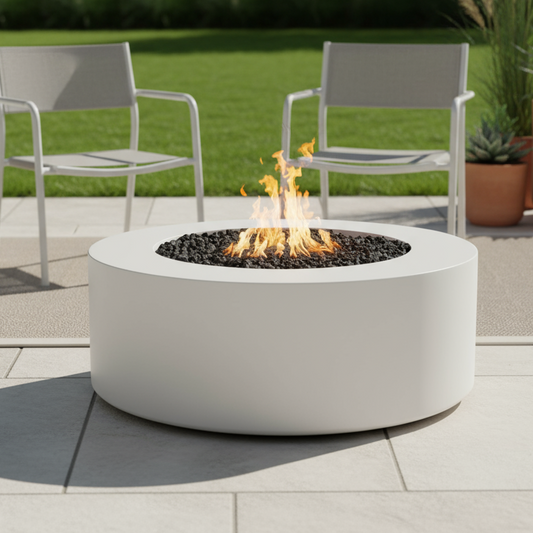Deck Safety: Using Fire Pits on Wood, Composite & Stone Decks

Share
"Can I put a fire pit on my deck?” It’s one of the most common homeowner questions—right alongside what do you put under a fire pit on deck, fire pit mat, and deck protect. This blog gives you a straight answer, then walks through risk by surface (wood vs composite vs stone), how to choose a heat shield, how much clearance you need, and the safer alternatives if your deck or code says no. We’ll keep the scope on deck surfaces, heat/weight, mats/guards, and stability, and link out for house distances, pergola heights, and landscaping: Fire Pit & Fire Pit Table Safety: Distances, Decks & Trees (U.S. Homeowner Guide)
Early refresher on distances from siding and eaves? Jump to: How Far Should a Fire Pit (or Table) Be From the House?
Key Takeaways
- Yes, sometimes you can put a gas fire pit or fire pit table on a deck—only when both the manufacturer manual and local code/HOA allow it.
- Wood decks: highest heat/spark risk. Use a fire‑resistant deck mat/heat shield, create an air gap with feet/stand, and keep clearances to railings/siding (see sizes below).
- Composite decks: vulnerable to heat deformation; use a manufacturer‑approved heat shield and confirm propane fire pit on composite deck use in writing, if possible.
- Stone/pavers/concrete: usually the safer landing pad next to a deck; still maintain distances, airflow, and drainage.
- Minimum working clearances (gas): 3–5 ft (0.9–1.5 m) sideways to walls/railings; 7–10+ ft (2.1–3.0 m) overhead to eaves/pergola beams.
- Unique tool: The 3‑Layer Deck Safety Stack (Surface → Thermal Barrier → Air Gap) + a pre‑flight checklist you can print.
- For the overall safety ecosystem (house distances, pergolas, trees, shutdown), see Fire Pit & Fire Pit Table Safety: Distances, Decks & Trees (U.S. Homeowner Guide)
Table of Content
-
Quick Answer: Wood vs Composite vs Stone/Pavers
-
The 3‑Layer Deck Safety Stack (Unique Framework)
-
Clearances, Railings & Adjacent Siding
-
Weight, Load & Stability
-
Safer Alternatives Near a Deck
-
Problem / Solution Mini‑Cases
-
Quick Reference Tables
-
Pre‑Use Deck Safety Checklist (Printable)
- FAQs
- Conclusion & Next Steps
1. Quick Answer: Wood vs Composite vs Stone/Pavers
Quick Reference — Surfaces vs. Allowed/Mitigations (gas appliances):
|
Deck/Surface |
Can you use a gas fire pit here?* |
Minimum mitigation |
Notes |
|
Wood (PT lumber, cedar, etc.) |
Sometimes (manual + code permitting) |
Heat‑rated mat/plate extending 6–12 in (15–30 cm) beyond footprint + 1–2 in (25–50 mm) air‑gap/feet |
Keep 3–5 ft (0.9–1.5 m) to rails & 7–10+ ft (2.1–3.0 m) overhead; supervise embers if any accessory is used |
|
Composite/PVC |
Sometimes (brand‑approved only) |
Brand‑approved heat shield (often metallic/ceramic) + air‑gap/feet |
Check brand’s written stance (search “propane fire pit on composite deck” + brand); many brands restrict open flame |
|
Stone/Pavers/Concrete |
Typically (if level & draining) |
Level pad; maintain drainage; consider tray for media |
Often the safer landing pad next to the deck |
|
Grass/Earth |
Not recommended near structures |
— |
Unstable; can scorch; move to a hard, level surface |
* Always follow appliance manual + local code/HOA. Wood‑burning units (including “smokeless fire pit” types) demand much larger setbacks and ember control—this guide focuses on gas appliances.
Short version:
- Wood deck: Allowed only when your appliance manual permits it and you use mitigation (mat + air gap + clearances). Sparks and radiant heat are the risk.
- Composite deck: Can shiny‑sheen, soften, or print under heat. Only proceed with a manufacturer‑approved shield and documented clearance guidance.
- Stone/pavers/concrete: Usually the safer zone for placement; consider building a small paver landing pad adjacent to the deck.
2. The 3‑Layer Deck Safety Stack (Unique Framework)
Layer 1 — Surface Readiness
- Level & rigid: Shim wobble out; aim for <1/8 in (3 mm) twist across the footprint.
- Non‑combustible zone: Sweep away debris; confirm drainage so water doesn’t collect under the unit.
- Placement: Favor areas with open sky and cross‑breeze, not alcoves.
Layer 2 — Thermal Barrier (the “deck protect” layer)
- Use a fire‑resistant deck mat / heat shield sized 6–12 in (15–30 cm) beyond the unit’s footprint on all sides (larger for big bowls).
- One piece, flat edges (no curl‑up trip hazard).
- Choose a shield with documented temperature ratings and, on composite decks, one that’s manufacturer‑approved.
Layer 3 — Air Gap & Hardware
- Elevate the fire pit using manufacturer feet, a stand, or low spacers to create a 1–2 in (25–50 mm) air gap.
- Ensure ventilation is not blocked; never tape or seal edges of the mat.
- For gas tables, route hoses so they don’t touch hot surfaces.
Mini‑wrap: Mats and deflectors reduce risk but do not override manufacturer clearances or code. Still maintain side and overhead spacing and follow shutdown steps.
3. Clearances, Railings & Adjacent Siding
Even on a deck, the house rules still apply.
- Side clearances to rails/walls: Work from burner edge (rectangles) or burner centerline (round). Maintain ≥3–5 ft (0.9–1.5 m) to rails, posts, planters, and siding.
- Overhead: Keep ≥7–8 ft (2.1–2.4 m) to soffits and pergola beams; 10+ ft (3.0 m) is more comfortable.
- Wind orientation: Rotate the long burner axis into the prevailing wind and add a wind guard (this doesn’t reduce clearances; it stabilizes flame).
- Corners and alcoves: Treat as higher risk for heat buildup—use the larger of any stated distances.
For full house‑adjacent rules (windows, doors, eaves), see How Far Should a Fire Pit (or Table) Be From the House?.
If the unit sits under a pergola or awning, jump to Pergolas, Awnings & Covered Structures.
4. Weight, Load & Stability
Decks carry live loads (people, furniture) on top of dead loads (structure). Your fire feature adds to both.
-
Add it up: appliance + media (lava rock/glass), propane cylinder (if present), table/furniture, and people seated nearby. A medium unit can easily exceed 200–400 lb (90–180 kg) before guests arrive.
-
Joist spans & posts: If your deck bounces, investigate reinforcement or move the unit to a paver landing pad.
-
Level checks: Adjust feet to prevent rocking.
- Anti‑tip: Keep hose slack tidy; no storage under the unit; avoid placing at deck edges with heavy foot traffic.
If you’re at (or near) structural limits, consider a small stone/paver pad next to the deck.
5. Safer Alternatives Near a Deck
- Build a landing pad: A 6–8 ft (1.8–2.4 m) diameter paver circle or a 5×7 ft (1.5×2.1 m) rectangle at ground level adjacent to the deck.
- Choose CSA/UL‑listed gas appliances with clear manuals and wind guards for breezier sites.
- Use lids or spark screens where appropriate (gas doesn’t throw sparks, but lids protect media when not in use).
- Route traffic smartly: Place the unit where egress paths remain clear.
Browse options and accessories: Fire Pit Table Collection | Accessories – Safety Mats, Wind Guards, Covers
6. Problem / Solution Mini‑Cases
Case 1 — Wood deck scorch marks
- Symptoms: Dark ring under the base; faint “char” smell.
- Likely causes: Thin mat, no air gap, higher flame height, or wind leaning flame toward rails.
-
Fix:
- Upgrade to a heat‑rated shield extending 8–12 in (20–30 cm) beyond the footprint.
- Add a 1–2 in (25–50 mm) air gap using feet/stand.
- Lower flame in gusts; add a wind guard.
- If marks persist, relocate to a paver pad.
- Upgrade to a heat‑rated shield extending 8–12 in (20–30 cm) beyond the footprint.
Case 2 — Composite deck sheen/odor
- Symptoms: Subtle gloss or softening on boards under the unit; warm plastic odor.
- Likely causes: Shield not brand‑approved; insufficient air gap; long high‑flame sessions.
-
Fix:
- Replace with the manufacturer‑approved heat shield.
- Increase air gap; shorten high‑heat sessions.
- Consider moving to a landing pad if conditions repeat.
- Replace with the manufacturer‑approved heat shield.
7. Quick Reference Tables
A) Deck Surface vs. Mitigation Matrix
This table summarizes what homeowners usually add for safer operation. Always follow the appliance manual and local rules.
|
Surface |
Heat/Spark Risk |
Required add‑ons |
Clearance reminder |
|
Wood |
High (combustible) |
Heat shield + air gap + wind guard (if breezy) |
3–5 ft (0.9–1.5 m) sides; 7–10+ ft (2.1–3.0 m) overhead |
|
Composite/PVC |
High (heat deformation) |
Brand‑approved shield + air gap |
Same as above; confirm brand stance |
|
Stone/Pavers/Concrete |
Low–moderate (radiant heat) |
Level pad + drainage |
Same as above |
B) Sizing the Shield (“What do you put under fire pit on deck?”)
- Shield size: Extend 6–12 in (15–30 cm) beyond all sides of the base; add more for larger bowls or breezy decks.
- Thickness & rating: Use rated mats/plates designed for flame features; verify temperatures and compatibility.
- Air gap: Target 1–2 in (25–50 mm) of airflow under the base.
8. Pre‑Use Deck Safety Checklist (Print This)
- □ Manual + local rules checked (allowed surfaces, clearances, venting).
- □ Deck surface confirmed: wood / composite / stone (note brand for composite).
- □ Heat shield/mat sized 6–12 in (15–30 cm) beyond footprint on all sides.
- □ Air gap provided with feet/stand (1–2 in / 25–50 mm).
- □ Clearances measured: 3–5 ft (0.9–1.5 m) side‑to rails/siding; 7–10+ ft (2.1–3.0 m) overhead.
- □ Wind plan: wind guard ready; burner oriented into prevailing wind.
- □ Load check: appliance + media + tank + people within deck’s capacity.
- □ Egress: walk paths clear; shut‑off and extinguisher accessible.
- □ Shutdown plan: follow OFF → supply OFF → cool → cover.
Need help for a specific deck brand or model? Contact a Specialist
9. FAQs
Are propane fire pit tables safe on composite decks?
Only when the deck manufacturer allows it and you use a brand‑approved heat shield plus an air gap. Keep clearances and monitor for heat sheen.
What do you put under a fire pit on a deck?
A heat‑rated shield (metal/ceramic mat or plate) that extends 6–12 in (15–30 cm) beyond the base, paired with feet/stand to create a 1–2 in (25–50 mm) air gap.
What is the best fire pit for composite deck use?
Look for a CSA/UL‑listed gas appliance with clear clearance data and optional wind guard. The “best fire pit for composite deck” depends on your brand’s shield requirements and your available clearances.
Can I use a propane fire pit for wood deck setups?
Sometimes—with the shield + air gap approach, correct clearances, and the model’s approval for deck use. Confirm local rules.
Do pavers protect a deck?
Pavers can form a separate landing pad next to the deck. On the deck itself, pavers may trap heat and add weight—use a rated shield instead.
How far from the railing should the fire pit be?
Plan for 3–5 ft (0.9–1.5 m) from rails and posts; if winds push flame toward the rail, increase spacing.
Is a fire pit mat enough by itself?
No. Pair the mat with an air gap, maintain clearances, and orient for wind. Mats reduce risk; they don’t replace the manual or code.
10. Conclusion & Next Steps
Fire features and decks can coexist—only when the manual, local rules, and your mitigation stack agree. If any one of those fails, use a paver or stone landing pad beside the deck and keep the flame in open air. Keep side/overhead clearances, maintain an air gap over a rated shield, and shut down properly after every session.
-
Explore certified appliances and accessories: Fire Pit Table Collection • Accessories – Safety Mats, Wind Guards, Covers
-
For distances, pergolas, trees, CO/ventilation, and shutdown, return to the pillar: Fire Pit & Fire Pit Table Safety: Distances, Decks & Trees (U.S. Homeowner Guide)
Need brand‑specific shield guidance? Contact a Specialist

